Eucomis: Care Guide for Flower
Eucomis, commonly known as Pineapple Lilies, are unique and striking plants that stand out in gardens and containers alike. Their most notable feature is their pineapple-like flower spikes, which are topped with a tuft of leaves, resembling the top of a pineapple. These blooms come in various shades, from white and green to deep purple, and have an exotic flair that captures attention. Due to their bold appearance and unusual flower structures, Eucomis is becoming increasingly popular in both garden landscapes and container displays. Whether used to add vertical interest or as a focal point in flower beds, Eucomis thrives in warm climates and adds an unexpected tropical vibe to any setting. With their easy-care nature, long-lasting blooms, and captivating presence, these flowers have become a must-have for gardeners looking to enhance their outdoor spaces with something distinctive and vibrant. Our gardening blog is a perfect place to find all the information you need!
Why Choose Eucomis for Your Garden or Home?
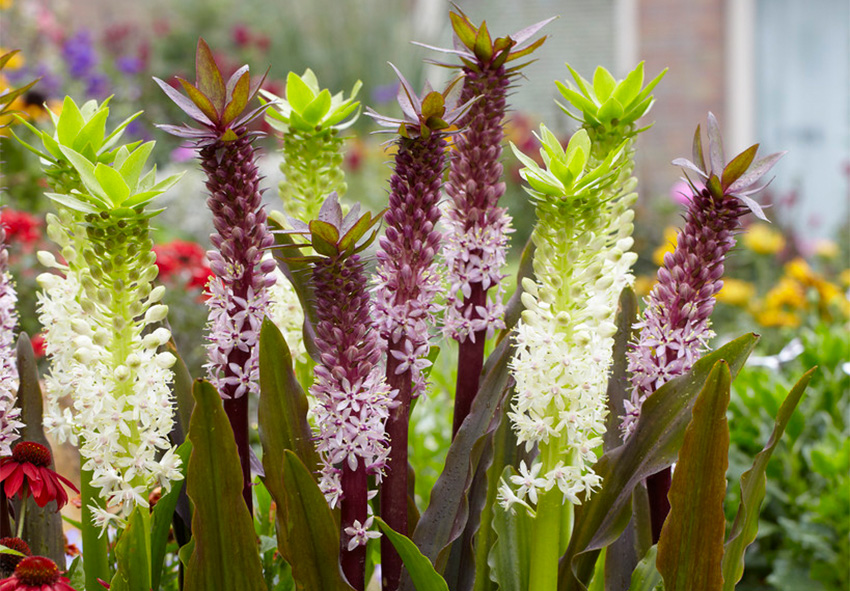
Eucomis offers a unique visual appeal with its striking flower spikes, making it an excellent addition to any garden or home setting. These exotic plants stand out due to their pineapple-like blooms, topped with a tuft of leaves, giving them a distinctive look that catches the eye. Not only are Eucomis plants beautiful, but they are also long-lasting. Their flower spikes bloom for weeks, providing continuous visual interest throughout the season. Another key benefit is their resilience in warm climates, where they thrive in full sun and tolerate heat well, making them perfect for gardens in temperate and subtropical areas. Eucomis is also relatively low-maintenance, requiring little more than well-drained soil and moderate watering. As a result, they are ideal for both experienced gardeners and beginners alike. Whether planted in the ground or used as part of a container display, Eucomis adds an exotic touch to any garden, helping create a tropical atmosphere while offering stunning blooms. Their adaptability, combined with their bold appearance, makes them a fantastic choice for gardeners who want to introduce something new and unusual into their plant collections.
The Most Popular Eucomis Varieties and Their Characteristics
Eucomis comes in a variety of types, each offering unique characteristics and different colors, shapes, and sizes. These variations make it easy to find a Eucomis that suits your specific landscaping needs, whether you’re looking for a bold, statement-making plant or something more subtle. The flower spikes vary in height and color, with some varieties offering deep, rich hues and others more delicate shades. The best Eucomis for your space will depend on your aesthetic preferences, as well as the growing conditions in your garden. Whether you want to make a dramatic impact or complement other plants, there’s a Eucomis variety to meet your needs. Let’s explore the different types of Eucomis and their unique characteristics.
Classic Green and White Eucomis Varieties
The green and white Eucomis varieties offer a timeless, elegant look with their soft, tropical appearance. These plants have striking flower spikes resembling pineapples, combined with lush green foliage that creates a clean, vibrant contrast. They are perfect for adding a classic touch to gardens or containers. Here are a couple of popular green and white varieties:
- Eucomis autumnalis: one of the most iconic varieties of Eucomis, Eucomis comosa features tall, upright spikes of greenish-white flowers, giving it a refined and classic appearance. The blooms appear in late summer, and their pineapple-like structure is surrounded by a crown of long, narrow leaves. This variety grows well in full sun and well-drained soil, making it perfect for any garden setting. Its tall flower spikes can reach up to 30 inches, making it a striking addition to garden beds or containers.
- Tugela Jade: another stunning variety with green and white flowers, but its blooms have subtle pink undertones, giving it a more delicate, softer appearance. The flower spikes are shorter than Eucomis comosa, growing to about 18-24 inches, which makes it perfect for smaller spaces or containers. The pale green flowers gradually transition into a creamy white, creating a beautiful, nuanced effect. This variety thrives in sunny spots and requires minimal care, making it an excellent addition to low-maintenance gardens.
Deep Purple and Burgundy Eucomis for a Bold Look
For gardeners looking to make a bold statement, the deep purple and burgundy Eucomis varieties are an ideal choice. These varieties feature rich, dark-colored flowers that provide contrast and visual drama, making them perfect for modern or tropical garden designs. The striking, pineapple-like flowers emerge in tall, sturdy spikes, creating a unique focal point. Below are some of the most popular deep purple and burgundy varieties:
- Sparkling Burgundy: a dramatic variety that stands out with its deep burgundy-colored flowers, which create a vibrant contrast against the green foliage. The flowers grow on tall spikes that can reach up to 36 inches in height, making this variety perfect for adding vertical interest to garden beds or containers. The striking dark blooms of Sparkling Burgundy are complemented by the sturdy green leaves that give the plant a tropical, exotic look. This variety thrives in full sun and is well-suited for gardeners looking for bold, eye-catching plants.
- Eucomis comosa: offers an intense purple color that adds a sense of mystery and elegance to the garden. The long flower spikes of Dark Star reach up to 30 inches, towering above the surrounding foliage. This variety is perfect for creating a dramatic contrast with lighter plants or surrounding greenery. Its deep purple flowers bloom in late summer and last for weeks, offering a prolonged display of color. Ideal for full sun and well-drained soil, Dark Star will thrive in any garden that requires bold and striking visuals.
Compact and Dwarf Eucomis for Small Gardens
Compact and dwarf Eucomis varieties are perfect for gardeners with limited space or those who want to add tropical flair to small gardens, patios, or containers. These smaller varieties still boast the signature pineapple-like flower spikes of their larger cousins, but in a more manageable size. Here are a couple of ideal compact and dwarf varieties:
- Eucomis vandermerwei: an excellent option for small gardens due to its compact size, reaching only 18-24 inches in height. This dwarf variety still produces tall, upright flower spikes, but they’re more proportional to the smaller plant. The flowers are pale green with a subtle pink blush at the base, giving it a delicate and softer look compared to other Eucomis varieties. It thrives in well-drained soil and full sun, making it an easy-to-care-for option for smaller spaces or containers.
- Octopus: another dwarf variety that’s perfect for compact gardens. Growing to just 12-18 inches, this variety features unique, spiky flower heads that resemble the tentacles of an octopus, adding texture and an interesting shape to any garden. The flowers of Octopus are white and pale green, offering a clean, tropical look that stands out in small spaces. It’s an ideal choice for gardeners looking to add a quirky yet elegant touch to containers or flower beds in smaller gardens.
Rare and Exotic Eucomis Hybrids
For those seeking something truly unique, rare and exotic Eucomis hybrids offer a blend of striking colors and forms that can’t be found in the more common varieties. These hybrids often combine the best qualities of multiple Eucomis species, resulting in beautiful, one-of-a-kind blooms. Here are a couple of the rarest and most exotic Eucomis hybrids:
- Eucomis bicolor: a rare hybrid known for its pale green to purple flowers, which are slightly more delicate compared to other Eucomis varieties. The flowers bloom on tall spikes, surrounded by a tuft of long, narrow leaves that resemble pineapple crowns. This hybrid creates a refined, exotic look in the garden and can grow to around 24-30 inches tall. It thrives in full sun and well-drained soil, and its unique appearance makes it a great choice for collectors or gardeners seeking something different.
- Pink Gin: an exciting hybrid with striking pink flowers that add a vibrant burst of color to any garden. The flowers bloom in large, dense clusters atop sturdy flower spikes, creating an eye-catching focal point. With its exotic look and rich pink hue, Pink Gin is a great way to add a tropical flair to your garden. Like other Eucomis varieties, it thrives in sunny, well-drained spots and can grow to about 24 inches in height. Its striking color and unique flower shape make it a favorite among those looking for a rare and beautiful plant to enhance their garden.
How to Plant and Grow Eucomis Successfully
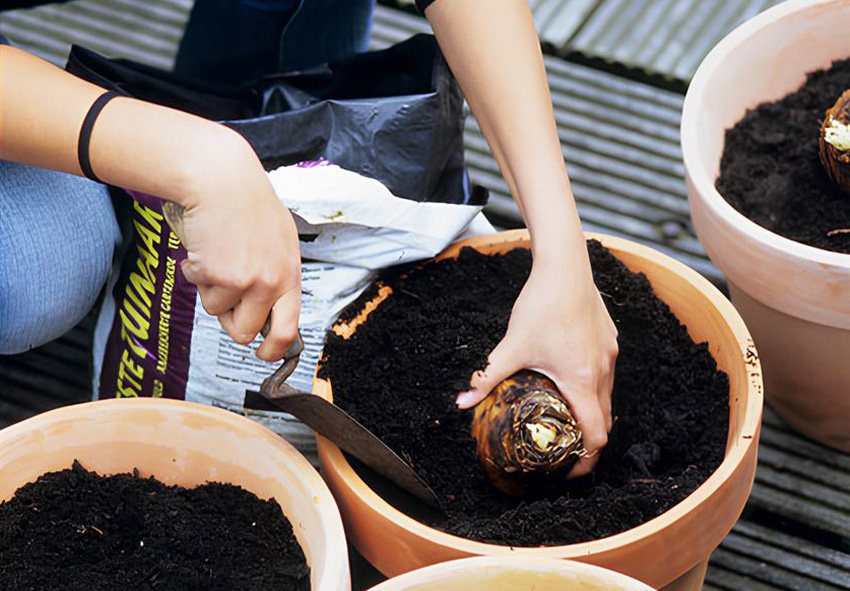
Eucomis, commonly known as pineapple lilies, are tropical plants known for their striking, pineapple-like flower spikes that add a unique touch to gardens and containers. Growing Eucomis successfully requires attention to detail, including selecting healthy bulbs, providing the right environment, and following proper planting techniques. These plants thrive in well-drained, fertile soil and full sun, making them perfect for adding height and visual interest to garden beds.
Start by selecting large, healthy bulbs free from damage or mold. Choose a location that receives full sun for at least six hours a day but also provides protection from excessive wind and cold drafts. Eucomis prefer slightly acidic to neutral soil (pH 6.0-7.0), so ensure your soil is well-draining. If necessary, amend heavy soil with organic material or sand to improve drainage. Plant the bulbs 4-6 inches deep, with the pointed end facing upward, and space them at least 12 inches apart to allow for proper airflow.
After planting, water the bulbs lightly to settle the soil, keeping it moist but not waterlogged. Eucomis require moderate watering, with less frequent watering in cooler temperatures. Protect young shoots from late frosts and mulch around the base to retain moisture. Follow these steps, and Eucomis will reward you with vibrant, pineapple-like flowers and healthy foliage.
Step-by-Step Guide to Planting Eucomis
Planting Eucomis is a relatively simple process that involves a few key steps. Ensuring healthy bulb selection, the correct planting depth, appropriate soil, and optimal growing conditions will contribute to your success. This step-by-step guide will walk you through the process of planting Eucomis and providing them with the right environment to thrive.
Step 1: Choosing Healthy Eucomis Bulbs
When selecting Eucomis bulbs, it’s important to choose large, firm bulbs with no visible signs of rot, mold, or damage. Healthy bulbs should feel firm and smooth when touched, indicating they are in good condition to sprout. Avoid bulbs that are soft, shriveled, or show any discolored spots, as these are signs of poor health that could lead to failed growth. It’s essential that the bulbs are stored correctly before planting to maintain their integrity.
Opt for bulbs that are plump and look fresh, as they contain the nutrients needed for strong growth. High-quality bulbs will have a better chance of sprouting and producing vibrant flowers. By selecting healthy bulbs, you set the stage for successful Eucomis growth, ensuring that they produce the characteristic pineapple-like flowers that make them such a popular choice among gardeners.
Step 2: Choosing the Right Soil and Location
For Eucomis to thrive, the right soil and location are key. Begin by ensuring your soil is well-draining and fertile. Poorly draining soil can lead to bulb rot, so it’s important to amend heavy or clayey soil with compost or sand to enhance drainage. The ideal pH range for Eucomis is between 6.0 and 7.0, which is slightly acidic to neutral. In terms of location, Eucomis prefers a full-sun spot where it can receive at least six hours of direct sunlight daily. However, it can tolerate partial shade, especially in regions with intense heat during summer.
Choose a location that will provide plenty of sunlight during the growing season, as this will encourage stronger growth and more abundant blooms. It’s also important to select a well-ventilated spot that will allow air circulation around the plant. A sunny, well-drained spot with good airflow will help ensure your Eucomis bulbs thrive and develop healthy foliage and flowers.
Step 3: Proper Planting Depth and Spacing
When planting Eucomis bulbs, it’s essential to place them at the correct depth and space them appropriately. To plant the bulbs, dig a hole that is about 4 to 6 inches deep. This depth ensures that the bulbs are buried enough to establish roots but not too deep to inhibit sprouting. The pointed end of the bulb should be facing upwards. If unsure which side is the pointed end, simply place the bulb with the narrow end facing up, as this will naturally guide the growth direction.
Additionally, when planting multiple bulbs, space them about 12 inches apart. This distance allows each plant to grow without overcrowding and provides enough room for air circulation, which helps prevent fungal diseases. The proper depth and spacing will help Eucomis plants develop strong root systems and ensure their growth is not stunted. This also helps them produce the stunning flower spikes that are so characteristic of this plant.
Step 4: Watering After Planting
Proper watering is essential after planting Eucomis bulbs. Right after planting, water the soil lightly to help settle it around the bulbs and ensure that the roots have enough moisture to establish themselves. However, it is important to avoid overwatering, as excess moisture can cause the bulbs to rot. The soil should be kept moist but not soggy, which means you should check the moisture levels regularly.
During warmer months, you can water more frequently, but always allow the top layer of soil to dry out between waterings. As the plants start to grow, you can reduce watering frequency, especially during cooler weather, when the soil will retain moisture for longer. Overwatering can be detrimental, so be sure to monitor the soil’s moisture level and adjust your watering routine accordingly. Proper watering is crucial in helping Eucomis establish a healthy root system and ensuring the bulbs don’t rot or dry out prematurely.
Step 5: Providing the Right Growing Conditions
After planting, it’s important to provide Eucomis with the right growing conditions to promote strong growth and beautiful blooms. One of the key factors is protecting young shoots from late frosts, as Eucomis is sensitive to cold weather. Use frost blankets, cloches, or row covers to shield your plants during sudden temperature drops in early spring. Eucomis also prefers moderate rainfall but can suffer from waterlogged conditions, so it’s essential to plant in areas with good drainage.
Applying mulch around the base of the plants can help retain moisture in the soil, suppress weeds, and regulate soil temperature. Mulch also protects the roots from the stress of extreme temperatures. In addition, Eucomis benefits from a stable environment, so avoid planting them in areas that are prone to strong winds. With the right care, Eucomis will reward you with vibrant, pineapple-like flower spikes and lush foliage throughout the growing season.
Essential Eucomis Care Tips for Healthy Growth
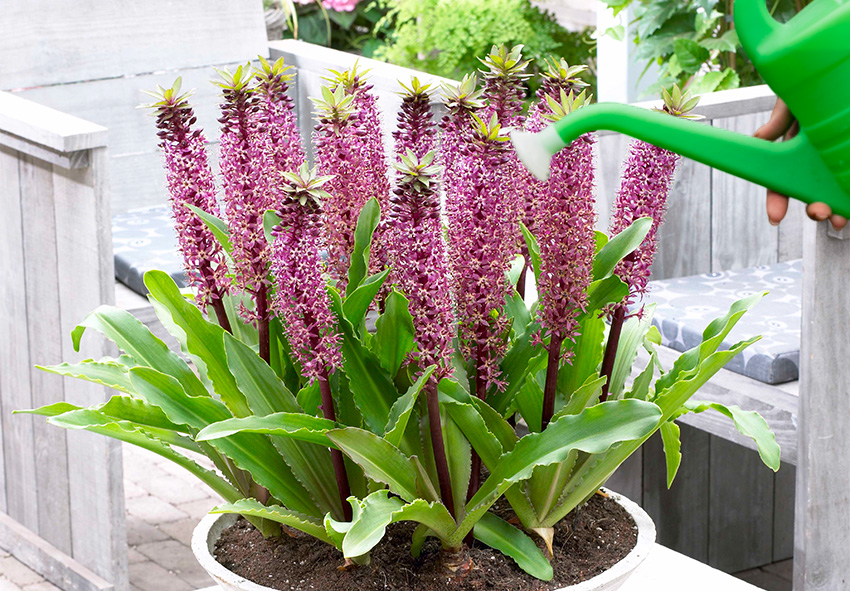
To ensure your Eucomis plants thrive, it’s crucial to meet their basic care requirements. These tropical plants are known for their striking appearance, with tall, pineapple-like flower spikes. To keep them healthy and vibrant, you’ll need to provide the right conditions, including adequate light, water, temperature, and feeding. With the correct eucomis bulb care, these flowers can flourish in gardens and containers, adding an exotic touch to any landscape.
Eucomis needs full sunlight for at least six hours a day, although they can tolerate partial shade. Proper watering is also essential—Eucomis enjoys moist soil, but it must be well-drained to prevent bulb rot. Their preferred growing temperature is between 18°C and 24°C (65°F to 75°F), but they should be protected from extreme heat or cold. Regular feeding with a balanced fertilizer ensures strong growth, but fertilizing should stop once buds appear. Additionally, mulching around the base of the plant helps maintain moisture and protects the roots from temperature fluctuations. With these care tips, your Eucomis will reward you with stunning blooms that last throughout the growing season.
How to Care for Eucomis After Planting
It’s important to know how to care for eucomis in the garden just as to learn how to care for eucomis indoors. After planting Eucomis, ensure they receive adequate sunlight and water. Water deeply once a week, keeping the soil moist but well-drained. Apply a balanced fertilizer every 3-4 weeks during the growing season, and stop fertilizing once buds appear. Protect from extreme temperatures and provide support for tall stems.
Step 1: Watering Eucomis the Right Way
Watering Eucomis correctly is essential to their health. Eucomis needs deep watering, typically once a week, to encourage strong root growth and keep the soil moist but well-drained. These plants do not thrive in soggy conditions, as overwatering can lead to bulb rot. Ensure the soil drains well, as excess moisture can suffocate the roots. When watering, apply enough water to reach the root zone but avoid creating puddles or waterlogging.
In periods of hot weather, you may need to water more frequently, but always check that the soil dries out slightly between waterings. In cooler temperatures or during the plant’s dormancy period, reduce the watering frequency. Overwatering during this time can prevent the plant from resting and can weaken the bulbs. A well-watered Eucomis will have strong, healthy foliage and bloom profusely when provided with the right care.
Step 2: Fertilizing for Strong Growth
Eucomis benefits from regular feeding, particularly when it is actively growing. Apply a balanced liquid fertilizer with equal parts nitrogen, phosphorus, and potassium (10-10-10) every 3-4 weeks during the growing season. This ensures that your Eucomis gets the nutrients it needs to develop strong stems and vibrant flowers. However, once buds start to form, stop fertilizing, as this will allow the plant to direct its energy into blooming rather than growing foliage. Over-fertilizing late in the season can lead to weak stems and fewer flowers.
Always follow the fertilizer manufacturer’s instructions to avoid damaging the plant. If you notice that the Eucomis is not blooming well or the leaves appear yellow, it may be a sign of nutrient deficiency, in which case additional fertilization might be necessary. A regular fertilizing routine will encourage healthy, vigorous growth and help your Eucomis produce its characteristic beautiful spikes.
Step 3: Providing Proper Light and Temperature
Eucomis thrives in bright, direct sunlight for at least six hours a day. However, it is also capable of tolerating partial shade, particularly in regions with extremely hot summers. If grown in partial shade, Eucomis may still produce blooms but might not be as vibrant or abundant. In hot climates, consider placing Eucomis in locations where it will receive morning sun or dappled shade during the hottest parts of the day. As a tropical plant,
Eucomis enjoys warmth but should be protected from extreme temperatures. The ideal temperature range is between 18°C and 24°C (65°F to 75°F). If temperatures exceed 30°C (86°F) or if there are strong winds, consider providing some shade or protection, as these conditions can stress the plant and reduce its ability to thrive. Similarly, ensure that your Eucomis is shielded from frost during colder months, as it is not frost-tolerant.
Step 4: Supporting Tall Eucomis Stems
Eucomis plants can grow tall, with flower spikes reaching up to 1 meter (3 feet) in some varieties. Because of their height, tall Eucomis stems may need support to prevent bending or breaking under the weight of the flowers. Use plant supports, such as stakes or cages, to keep the flower spikes upright and sturdy throughout the blooming period. Supporting the stems ensures that the flowers remain upright, creating a striking visual display. Additionally, deadheading spent flowers will encourage further blooming and prolong the flowering season.
As the flowers begin to fade, remove them just above the first set of leaves. This helps maintain the plant’s energy, promoting continued growth and reducing the likelihood of disease. By providing support and removing dead blooms, you will not only enhance the appearance of your Eucomis but also encourage a more productive and long-lasting blooming season.
How to Encourage Your Eucomis to Bloom Again
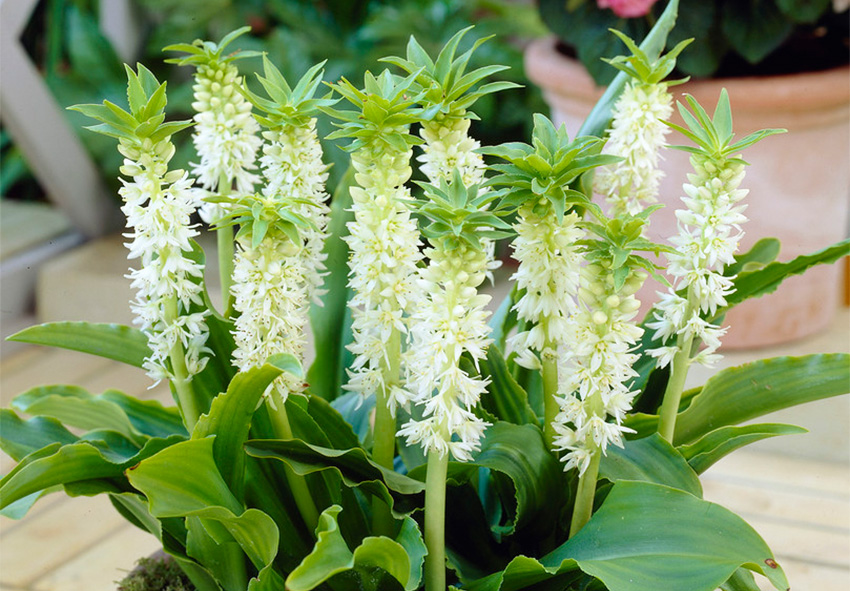
Eucomis plants are known for their striking, pineapple-like flower spikes, but sometimes they may not rebloom as expected. There are several reasons why Eucomis may fail to produce flowers again, including poor growing conditions, lack of nutrients, or insufficient care during their dormant period. Ensuring they rebloom requires proper post-bloom care, preparing the plants for dormancy, and occasionally dividing and transplanting bulbs.
To encourage your Eucomis to bloom again, provide them with the right growing conditions. These plants need regular watering, full sunlight, and well-draining soil throughout the growing season. Additionally, fertilizing the plant with a balanced fertilizer helps promote strong flower production. However, after blooming, proper care during dormancy is equally important. Reducing watering as the foliage dies back in autumn allows the bulbs to rest and prepare for the next growing season.
Dividing and transplanting Eucomis bulbs every 3-4 years can also help maintain their vigor and improve flowering. Fresh soil and a little more space give the bulbs room to grow and flower more profusely. By following these steps, you can enjoy another round of stunning Eucomis blooms year after year.
Step-by-Step Guide to Ensuring Reblooming
To ensure reblooming, start by deadheading spent flowers to encourage new blooms. Cut back flower stems but leave the foliage intact for energy storage. Prepare your Eucomis for dormancy by reducing watering as the foliage dies back. Divide and transplant bulbs every 3-4 years for better bloom performance.
Step 1: Deadheading and Post-Bloom Care
After your Eucomis blooms, removing spent flowers is crucial for encouraging new blooms. Deadheading involves cutting back the flower stems just above the first set of leaves, which helps redirect energy into forming new flowers rather than maintaining old, faded blooms. However, it’s important to leave the foliage intact during this process. The leaves play a vital role in energy storage for the plant, allowing it to store nutrients that will fuel future blooms. As the plant continues to grow, the remaining foliage will help ensure the bulbs have enough energy to produce healthy flowers in the next growing season. Be mindful not to cut back the leaves too early, as this could hinder the plant’s ability to store energy. With deadheading and proper care, your Eucomis should be able to flower again next season, ensuring a long-lasting and vibrant display of pineapple-like blooms.
Step 2: Preparing Eucomis for Dormancy
As autumn approaches and the temperatures drop, Eucomis begins to die back. At this time, it’s important to reduce watering gradually. Allow the foliage to naturally yellow and wither, signaling the plant is entering its dormant phase. This dormancy period is essential for the health of the Eucomis bulb, as it allows the plant to rest and rejuvenate. During dormancy, stop watering the Eucomis entirely to avoid excess moisture around the bulb, which can lead to rot. If you live in an area with frost, it’s advisable to lift the bulbs and store them in a cool, dry place for the winter. If temperatures remain mild, you can leave the bulbs in the ground, but protect them from frost by applying a thick mulch layer over the soil. By allowing the Eucomis to rest properly during its dormant phase, it will be better prepared for the next growing season and produce stronger blooms.
Step 3: Dividing and Transplanting Eucomis
To ensure healthy growth and improve the chances of reblooming, it’s important to divide and transplant Eucomis bulbs every 3-4 years. As the bulbs grow, they can become crowded, which can inhibit their ability to flower and thrive. Digging up the bulbs at the end of the growing season and carefully separating the smaller offsets from the main bulb will give each bulb more space to grow. Replant the divided bulbs in fresh, well-draining soil for the best results. This also helps refresh the soil, providing new nutrients for the bulbs to grow strong. By dividing and transplanting your Eucomis, you can rejuvenate the plants and encourage them to bloom more vigorously. Fresh soil, proper spacing, and ample sunlight will ensure your Eucomis continues to produce beautiful blooms for years to come.
Common Problems with Eucomis and How to Fix Them
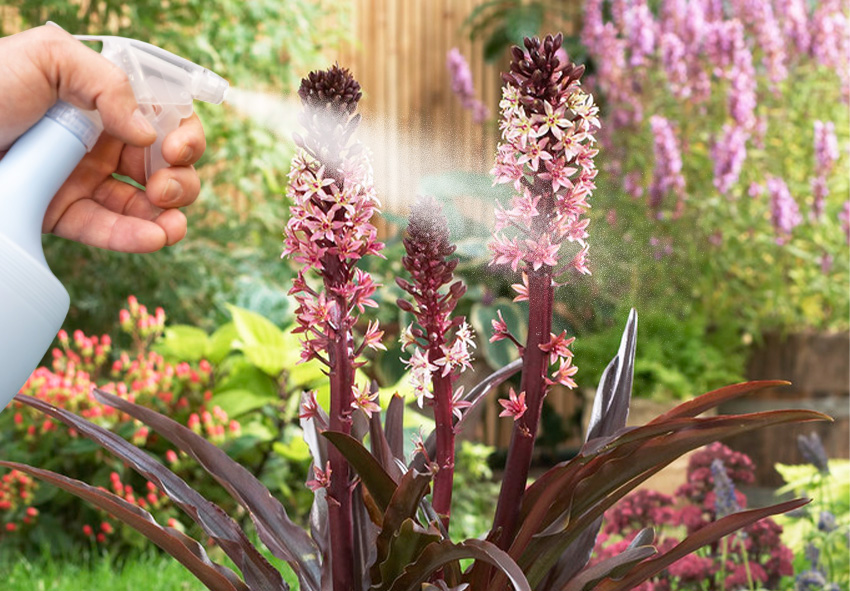
Eucomis, or pineapple lilies, are beautiful and relatively easy-to-care-for plants, but they can experience a few common issues that might hinder their growth or flowering. Understanding these problems and knowing how to address them can help you keep your Eucomis thriving. From pest infestations to environmental factors, there are a few common problems to be aware of.
A common issue is Eucomis not blooming, often caused by insufficient sunlight, overcrowding, or improper care during dormancy. To address this, ensure that your Eucomis is planted in a sunny location and space the bulbs out to avoid overcrowding. Regularly divide the bulbs every few years to encourage blooming.
Another problem is yellowing leaves or weak growth, which can occur due to overwatering or nutrient deficiencies. To resolve this, check that the soil drains well and avoid excessive watering. Additionally, use a balanced fertilizer to supply the plant with the nutrients it needs to thrive.
Eucomis bulbs may also experience rot due to poor drainage or excessive moisture. To prevent this, ensure proper spacing and soil drainage. Adequate air circulation is also essential for healthy bulb growth, so avoid planting bulbs too close together.
Troubleshooting Guide
In this section, we’ll go over some of the most common issues with Eucomis plants, providing a clear cause and solution for each. With the right care and attention, you can quickly remedy these problems and get your Eucomis back on track.
Issue 1: Eucomis Not Blooming
Sometimes, your Eucomis plant may fail to bloom, despite providing it with what seems to be ideal care. Understanding the reasons behind this lack of flowering will help you take the necessary steps to improve the situation.
Cause:
- Eucomis plants require plenty of sunlight to thrive and bloom. If they are not receiving enough direct sunlight, they may not produce flowers. Additionally, overcrowding can inhibit growth and prevent flowering, as the bulbs don’t have enough room to develop properly.
Solution:
- To encourage blooming, ensure that your Eucomis is planted in a sunny spot with at least 6 hours of sunlight each day.
- If the plant is overcrowded, divide the bulbs every 3-4 years to give them more space to grow.
- Dividing the bulbs will refresh the soil, improve root health, and boost flower production.
Issue 2: Yellowing Leaves or Weak Growth
Yellowing leaves or weak growth can be a sign that your Eucomis is not receiving the proper care it needs. This problem is typically related to water or nutrient issues that affect the plant’s overall health.
Cause:
- One of the most common causes of yellowing leaves and weak growth is overwatering, which can lead to root rot. When the roots are constantly wet, they cannot absorb nutrients effectively. Additionally, a lack of nutrients in the soil can cause the plant to grow weak and yellow.
Solution:
- To resolve this issue, check the soil for drainage and make sure it is not retaining too much water. If necessary, amend the soil with organic matter to improve drainage.
- To correct nutrient deficiencies, use a balanced fertilizer (such as 10-10-10) every 3-4 weeks to encourage healthy growth.
- By reducing overwatering and providing proper nutrients, your Eucomis will recover and thrive.
Issue 3: Eucomis Bulbs Rotting
Bulb rot is a common issue for Eucomis plants, especially if the conditions are not ideal. This problem can significantly damage or kill the plant if not addressed quickly.
Cause:
- The primary cause of bulb rot is poor drainage, which results in excess moisture around the bulb. If the soil remains too wet for too long, the bulbs may begin to rot. Inadequate air circulation around the bulb can also contribute to this issue.
Solution:
- To prevent rot, make sure the soil is well-draining. You may need to amend heavy, clay-like soil with sand or organic matter to improve drainage.
- Ensure the bulbs are spaced 12 inches apart to allow for proper air circulation.
These steps will prevent the bulbs from becoming waterlogged and reduce the risk of rot, helping your Eucomis thrive for years to come.
Propagating Eucomis: Growing More Beautiful Blooms
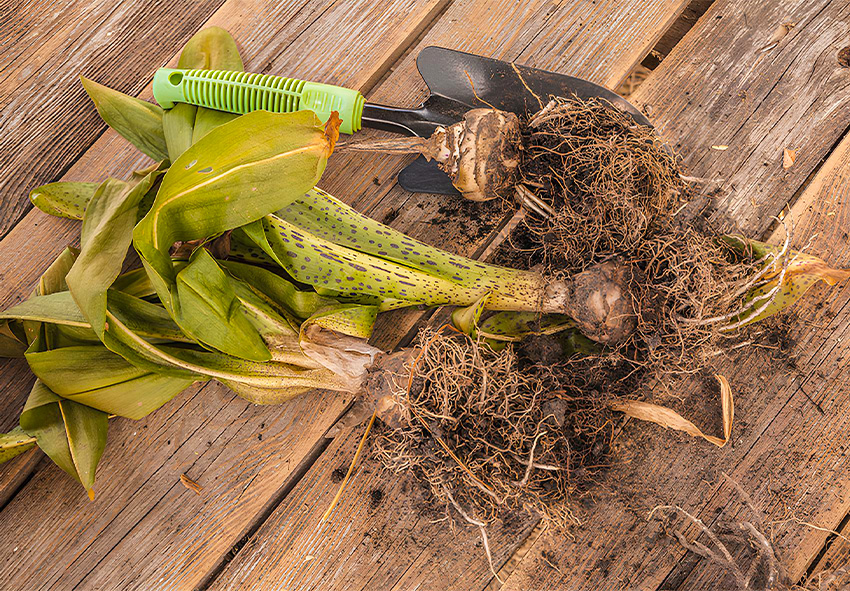
Eucomis, or pineapple lilies, are beautiful plants that can be easily propagated to multiply your collection. Propagation is a rewarding process that allows you to grow more blooms, whether you’re expanding your garden or sharing plants with others. There are two primary methods for propagating Eucomis: dividing bulbs and growing from seeds. Both methods are relatively simple, but it’s important to understand the timing and conditions that will produce the best results.
The most effective and fastest method for propagation is dividing the bulbs. This is best done in late summer when the plant begins to enter dormancy. The second method is growing Eucomis from seeds, though this takes more patience and time. While growing from seeds may take several years before blooming occurs, it can still be an exciting way to add new and unique plants to your garden. Regardless of the method, successful propagation depends on proper care and maintenance during the growing season.
By learning how to propagate Eucomis successfully, you can enjoy a beautiful display of their pineapple-like blooms year after year. Whether you’re looking to fill your garden or expand your collection, propagation ensures that you can enjoy the beauty of Eucomis plants in abundance.
How to Propagate Eucomis Step-by-Step
To propagate Eucomis, you can either divide the bulbs or grow them from seeds. Dividing bulbs in late summer is the quickest method, while growing from seed takes longer—2-4 years before flowering. Both methods require proper care, including adequate sunlight, water, and well-drained soil for successful propagation.
Step 1: Dividing Eucomis Bulbs (The Best Method)
The best method of propagating Eucomis is by dividing the bulbs. To do this, wait until late summer when the plant starts to go dormant. At this point, carefully dig up the bulbs from the ground. Separate the healthy offsets from the main bulb. These offsets, which are smaller bulbs attached to the original one, can be replanted to grow new Eucomis plants. It’s important to ensure the bulbs are healthy and free from any signs of rot.
Replant the divided bulbs in the next growing season, spacing them about 12 inches apart to allow for proper growth. Dividing bulbs is a reliable and quick method to increase your Eucomis collection, ensuring more blooms year after year. Remember to provide the necessary sunlight, well-draining soil, and adequate watering to ensure the newly planted bulbs thrive.
Step 2: Growing Eucomis from Seeds
Growing Eucomis from seeds is a slower process but can be very rewarding. To start, sow the seeds in cool conditions, such as a greenhouse or a cold frame, for better germination. The seeds require consistent moisture but must be kept in a well-drained mix to prevent rotting. Be patient—expect it to take 2-4 years before the plants flower. This method is best suited for those who want to experiment or develop new Eucomis varieties.
While it may take longer to see results, growing Eucomis from seeds can be a fun way to enjoy these plants over the long term. Once the seedlings are established, transplant them into larger pots or directly into your garden, following the same care requirements as the mature plants. Growing from seed is an exciting way to increase your collection, but be prepared for a long wait before blooming.
Frequently Asked Questions (FAQs) about Eucomis
1. How often should I water Eucomis?
Eucomis prefers consistent moisture during its growing season (spring and summer). Water deeply when the soil starts to dry out but avoid overwatering, as the bulbs can rot in soggy soil. Reduce watering in late fall as the plant enters dormancy. If grown indoors, ensure the pot has proper drainage and allow the soil to dry slightly before the next watering. Overwatering is one of the most common causes of Eucomis health issues.
2. Can Eucomis bulbs be ordered from your online store?
Our online store Dutch-bulbs.com offers a wide selection of Eucomis bulbs, making it easy for you to add these elegant beauties to your garden. We source our bulbs from reputable growers to ensure you receive high-quality specimens. Simply browse our online catalog, select your preferred Eucomis varieties, and follow the easy ordering process.
3. How do I overwinter Eucomis bulbs?
In colder climates (below USDA Zone 7), Eucomis bulbs should be lifted and stored for winter. After the foliage dies back in fall, dig up the bulbs, allow them to dry for a few days, and store them in a cool, dry place like a basement or garage. If grown in pots, simply move the container to a frost-free area. In warmer climates, leaving the bulbs in the ground with a thick mulch layer provides adequate protection.
4. Can Eucomis be grown indoors?
Yes, Eucomis can be grown indoors if they receive ample sunlight. Place the plant near a south- or west-facing window to ensure at least 6 hours of bright light daily. Use a well-draining potting mix and a container with drainage holes. Water moderately, allowing the top inch of soil to dry out between waterings. During winter dormancy, reduce watering and keep the plant in a cool, dry area to encourage healthy regrowth in spring.
5. Why isn’t my Eucomis blooming?
If Eucomis fails to bloom, it could be due to insufficient sunlight, overcrowding, or poor soil conditions. Ensure the plant gets at least 6 hours of direct sun daily. If bulbs are planted too deeply, they may struggle to bloom—make sure they are positioned 2–3 inches below the soil surface. Lack of nutrients can also impact flowering, so apply a phosphorus-rich fertilizer in early summer to encourage better blooms.
Published: 02.04.2025
